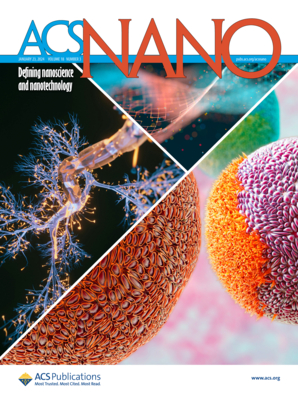Remodeling of Effector and Regulatory T Cells by Capture and Utilization of miRNAs Using Nanocomposite Hydrogel for Tumor-Specific Photothermal Immunotherapy
IF 15.8
1区 材料科学
Q1 CHEMISTRY, MULTIDISCIPLINARY
引用次数: 0
Abstract
In immunotherapy for malignant tumors, the dysregulation of the balance between effector T cells and regulatory T cells (Tregs) and the uncertain efficacy due to individual differences have been considered as two critical challenges. In this study, we engineered an injectable nanocomposite hydrogel system (SNAs@M-Gel) capable of suppressing Treg proliferation and blocking PD-1/PD-L1-mediated immune evasion effectively, achieved through the stimulus-responsive modulation of multiple tumor-associated microRNAs. Simultaneously, this system enables microRNA-dependent photothermal immunotherapy, facilitating a highly efficient and personalized approach to tumor treatment. Specifically, oxidized sodium alginate (OSA) and cancer cell membrane (CCM)-encapsulated spherical nucleic acid nanoparticles (SNAs@M) were used to construct the SNAs@M-Gel hydrogel in situ at the tumor site through the formation of pH-sensitive Schiff base bonding and cross-linking using endogenous calcium ions (Ca2+). During treatment, SNAs@M-Gel was retained locally for up to 10 days, and SNAs@M nanoparticles were continuously released into the tumor microenvironment. Through the targeting ability of CCM, SNAs@M precisely entered tumor cells and specifically hybridized with the overexpressed miR-214 and miR-130a, leading to a significant downregulation of PD-L1 expression on tumor cells and the restoration of cytotoxic T lymphocyte (CTL) function suppressed by Tregs, thereby remodeling the immune microenvironment. In addition, miRNAs functioned as cross-linking agents, facilitating the aggregation of SNAs and allowing the localized production of photothermal agents directly inside tumor cells, which, under near-infrared (NIR) irradiation, promoted highly selective photothermal therapy. This cascade of events not only led to the destruction of the primary tumor but also resulted in the release of a substantial number of tumor-related antigens, which triggered the maturation of adjacent dendritic cells (DCs) and subsequent priming of tumor-specific CTLs, while simultaneously depleting Tregs, thereby reversing the tumor-promoting immune microenvironment and enhancing the overall therapeutic efficacy of photothermal immunotherapy.

在恶性肿瘤的免疫治疗中,效应T细胞和调节性T细胞(Tregs)之间的平衡失调以及个体差异导致的疗效不确定一直被认为是两大关键挑战。在这项研究中,我们设计了一种可注射的纳米复合水凝胶系统(SNAs@M-Gel),该系统通过对多种肿瘤相关微RNA的刺激响应调控,能够有效抑制Treg增殖并阻断PD-1/PD-L1介导的免疫逃避。同时,该系统还能实现微RNA依赖性光热免疫疗法,从而促进高效、个性化的肿瘤治疗方法。具体来说,氧化海藻酸钠(OSA)和癌细胞膜(CCM)包裹的球形核酸纳米颗粒(SNAs@M)通过形成pH敏感的席夫碱结合,并利用内源性钙离子(Ca2+)交联,在肿瘤部位原位构建SNAs@M-凝胶水凝胶。在治疗过程中,SNAs@M-凝胶可在肿瘤局部保留长达10天,而SNAs@M纳米颗粒可持续释放到肿瘤微环境中。通过CCM的靶向能力,SNAs@M能精确进入肿瘤细胞,并与过表达的miR-214和miR-130a特异性杂交,从而显著下调肿瘤细胞上PD-L1的表达,恢复被Tregs抑制的细胞毒性T淋巴细胞(CTL)功能,从而重塑免疫微环境。此外,miRNAs 还能起到交联剂的作用,促进 SNAs 的聚集,使光热剂直接在肿瘤细胞内局部产生,在近红外(NIR)照射下,促进高选择性光热疗法。这一系列事件不仅摧毁了原发肿瘤,还释放出大量与肿瘤相关的抗原,引发邻近的树突状细胞(DCs)成熟,进而激活肿瘤特异性 CTLs,同时消耗 Tregs,从而逆转肿瘤促进免疫微环境,提高光热免疫疗法的整体疗效。
本文章由计算机程序翻译,如有差异,请以英文原文为准。
求助全文
约1分钟内获得全文
求助全文
来源期刊

ACS Nano
工程技术-材料科学:综合
CiteScore
26.00
自引率
4.10%
发文量
1627
审稿时长
1.7 months
期刊介绍:
ACS Nano, published monthly, serves as an international forum for comprehensive articles on nanoscience and nanotechnology research at the intersections of chemistry, biology, materials science, physics, and engineering. The journal fosters communication among scientists in these communities, facilitating collaboration, new research opportunities, and advancements through discoveries. ACS Nano covers synthesis, assembly, characterization, theory, and simulation of nanostructures, nanobiotechnology, nanofabrication, methods and tools for nanoscience and nanotechnology, and self- and directed-assembly. Alongside original research articles, it offers thorough reviews, perspectives on cutting-edge research, and discussions envisioning the future of nanoscience and nanotechnology.
 求助内容:
求助内容: 应助结果提醒方式:
应助结果提醒方式:


